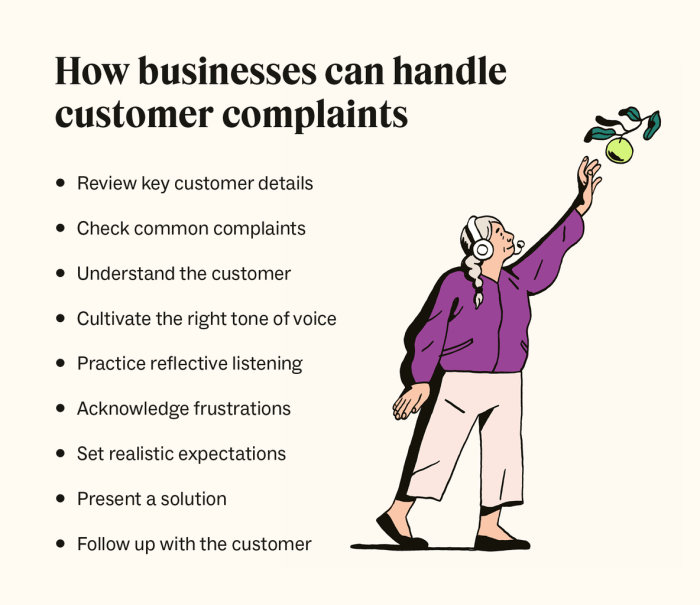Handling Customer Feedback takes center stage in the business world, offering insights into the vital role feedback plays in customer satisfaction and company reputation. Get ready to dive into the world of customer feedback with a fresh perspective!
Exploring different methods, analysis techniques, and response strategies will equip you with the tools needed to excel in managing customer feedback effectively.
Importance of Handling Customer Feedback
Customer feedback is a vital component for business growth and success. It provides valuable insights into the customer experience, allowing companies to identify areas of improvement, enhance product or service offerings, and ultimately increase customer satisfaction and loyalty.
Enhancing Customer Satisfaction
- By actively listening to customer feedback, businesses can address issues promptly and make necessary improvements to meet customer expectations.
- Implementing changes based on feedback can lead to higher levels of customer satisfaction, resulting in repeat business and positive word-of-mouth referrals.
- Customers feel valued and appreciated when their feedback is taken into consideration, fostering a strong relationship between the business and its clientele.
Impact on Company Reputation
- Ignoring or mishandling customer feedback can have detrimental effects on a company’s reputation, leading to negative reviews, decreased customer trust, and potential loss of business.
- Negative feedback, if not addressed properly, can spread quickly through social media and online review platforms, tarnishing the company’s image and credibility.
- On the other hand, effectively managing feedback and resolving issues in a timely manner can showcase the company’s commitment to customer satisfaction and enhance its reputation in the marketplace.
Strategies for Gathering Customer Feedback
Gathering customer feedback is crucial for businesses to improve their products and services. There are various methods for collecting feedback from customers, each with its own advantages and disadvantages. Let’s explore some of these strategies below.
Surveys
Surveys are a common method used to gather feedback from customers. Companies can create online or offline surveys to ask specific questions about their experience with the product or service. Surveys allow for quantitative data analysis and can provide valuable insights into customer preferences and satisfaction levels.
Feedback Forms
Feedback forms are another effective way to collect customer feedback. These forms can be placed on websites, in-store, or sent via email. They allow customers to provide detailed feedback on their experience, suggestions for improvement, and any issues they may have encountered. Feedback forms provide more qualitative data compared to surveys.
Social Media Monitoring
Monitoring social media platforms like Twitter, Facebook, and Instagram can also help businesses gather customer feedback. By keeping track of mentions, comments, and reviews, companies can identify trends, address customer concerns in real-time, and engage with their audience. Social media monitoring provides immediate feedback and allows for direct interaction with customers.
Advantages and Disadvantages, Handling Customer Feedback
Surveys
Provide quantitative data, but may have low response rates.
Feedback Forms
Offer detailed qualitative feedback, but require customers to take the time to fill them out.
Social Media Monitoring
Real-time feedback and direct interaction, but can be overwhelming to manage.
Examples of Successful Companies
Starbucks
Utilizes customer feedback through its mobile app to improve menu items and customer experience.
Amazon
Encourages customers to leave reviews on products, which helps other shoppers make informed purchasing decisions.
Airbnb
Sends post-stay surveys to guests to gather feedback on their accommodations and overall experience.Overall, implementing a combination of these feedback collection strategies can help businesses gather valuable insights and make informed decisions to enhance customer satisfaction and loyalty.
Analyzing and Categorizing Feedback

Analyzing and categorizing customer feedback is crucial for businesses to understand their customers’ needs and preferences. By carefully examining feedback, companies can identify trends, common issues, and areas for improvement. This process allows businesses to make informed decisions that can ultimately lead to increased customer satisfaction and loyalty.
Analyzing Customer Feedback
When analyzing customer feedback, companies should look for recurring themes or patterns. This involves reading through feedback from various sources, such as surveys, reviews, and social media comments. By identifying common s or phrases, businesses can pinpoint areas that are consistently mentioned by customers. Analyzing feedback can also help in understanding the overall sentiment towards products or services.
- Utilize sentiment analysis tools to gauge whether feedback is positive, negative, or neutral.
- Create word clouds to visually represent the most frequently mentioned words in feedback.
- Track metrics such as Net Promoter Score (NPS) to quantify customer satisfaction levels.
Categorizing Feedback
Categorizing feedback based on its nature and relevance is essential for organizing and prioritizing action items. Feedback can be classified into categories such as positive, negative, or neutral, as well as by specific product or service features. By categorizing feedback, businesses can focus on addressing the most critical issues first and allocating resources effectively.
- Positive Feedback: Acknowledge and reinforce what customers appreciate about the product or service.
- Negative Feedback: Address concerns promptly and work towards resolving customer issues to improve satisfaction.
- Neutral Feedback: Look for opportunities to turn neutral feedback into positive experiences by seeking clarification or feedback on potential improvements.
Importance of Feedback Analysis
Feedback analysis is instrumental in making data-driven decisions that can drive business growth and enhance customer relationships. By understanding customer sentiments and preferences, businesses can tailor their strategies to meet evolving needs and stay ahead of the competition. Feedback analysis provides valuable insights that can guide product development, marketing campaigns, and overall business operations.
Responding to Customer Feedback

Responding to customer feedback is crucial for maintaining a positive relationship with your customers. It shows that you value their input and are committed to continuously improving your products or services based on their feedback.
Best Practices for Responding to Customer Feedback
- Respond promptly: Acknowledge all feedback in a timely manner to show customers that you are actively listening.
- Personalize responses: Address customers by their name and tailor your response to their specific feedback.
- Express gratitude: Thank customers for taking the time to provide feedback, whether it’s positive or negative.
- Take ownership: Accept responsibility for any shortcomings and assure customers that you are working to address them.
Tips for Addressing Negative Feedback in a Constructive and Empathetic Manner
Negative feedback can be an opportunity for growth and improvement. Here are some tips for handling negative feedback effectively:
- Listen actively: Pay attention to the customer’s concerns and validate their feelings.
- Apologize sincerely: Empathize with the customer’s experience and offer a genuine apology for any inconvenience caused.
- Provide a solution: Offer to rectify the situation or provide compensation to make amends for the negative experience.
- Follow up: Ensure that the issue has been resolved to the customer’s satisfaction and ask for feedback on the resolution process.
Examples of Companies Turning Negative Feedback into Positive Outcomes
- Amazon: Amazon actively responds to negative feedback by offering refunds, replacements, or discounts to dissatisfied customers, turning their experience around.
- Zappos: Zappos is known for its exceptional customer service, which includes addressing negative feedback promptly and going above and beyond to exceed customer expectations.
- Delta Airlines: Delta Airlines has effectively turned negative feedback into opportunities for improvement, implementing changes based on customer suggestions to enhance the overall travel experience.






